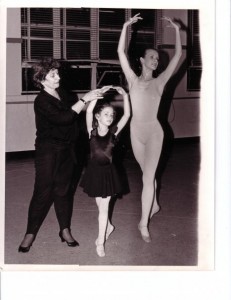1. What are some things that teachers can do to improve their instruction in the dance classroom?
My advice would be watch others teach when you get a chance. I love to watch others, I gain so much insight into who I am as a teacher and what skills I draw upon. It doesn’t even have to be dance teachers you observe. We all have our strengthens and weaknesses and by watching others you gain new perspectives, new tools and learn new approaches. It also can help clarify your own teaching philosophy.
2. Developmentally, what are some of the major concerns a dance teacher should be aware of when teaching young children?
Be aware that all children develop differently and even though there are definite physical milestones some children will reach them ahead or behind others.
I watch for social and emotional cues a lot. Eye contact is huge with me. If a child is having a hard time making eye contact with you and his or her peers, there could be an underlying issue.
Also, in order for movement integration, children need to be able to cross the midline of their bodies. What this means is having one side of the body cross over to the other side, like taking your right hand and crossing the center of your body to touch your left knee. I was teaching a group of first graders and we were performing a mixing gesture on the floor. I noticed one of the children was turning around in a circle instead of reaching across his body. At first I thought he was embellishing the movement so I gave the class clear directions about how we were mixing. I changed the levels and the speed and it became quite clear to me this was very challenging for him.
We all have one side that is stronger than the other. It is important, however, to observe if any of your students have a noticeable disparity between the right and left.
Eye hand coordination is essential in the development of fine motor skills. Notice if a child is having a hard time with catching scarves, tracing shapes in the air or giving you a high five for a job well done.
If a child is having difficulties, it is important to talk to the parents or teachers. Remember, each child develops differently but the challenges he or she is encountering might indicate a larger underlining issue.
3. How do you handle teaching class when there are different levels of ability?
The elements of movement remain constant so no matter what the level of the students the elements and concepts are always accessible. Usually when I teach I pick a theme. The exercise may be the same from the previous week but our focus changes. One week we may be emphasizing space and the next week it might be weight or a sense of grounding.
You can always challenge a more advanced dancer to explore the movement quality while a dancer who is struggling can focus on the mechanics or vice versa. You could have the technically advanced dancer work on multiple pirouettes while a beginner can work on the push or spring up to posse. The important thing is to keep everyone focused, challenged and engaged.
4. Can children with special needs benefit from dance classes-and if so, how?
Yes, yes, yes!!! The benefits are endless, just like the benefits are endless for any individual. Dance works on spatial awareness, body awareness, gross motor skills, balance, body integration, body recognition, non-verbal communication and personal expression. For kids with special needs like autism, ADHD, sensory issues and non-verbal learning disabilities dance can have a huge impact on their lives and the lives of their families. Dance is a valuable tool to teach these important skills.
5. In your opinion, what is the value of having children take dance classes if they are not going to become a dancer?
Well, for all the reasons I mentioned in the last question. If you have an understanding of your body and a sense of ownership the sky is the limit. I tell teachers I work with that kids don’t own much and are not in control of much in their lives. They do however, have control over their bodies. And when you have a sense of your body’s abilities it builds tremendous self confidence. Dance also teaches a child how to follow directions, how to give directions and how to problem solve. These are skills that we need to become successful individuals whatever road we choose for ourselves. And dance enriches our lives, like all the arts. We all deserve to have dance in our life whether it’s dancing in our room, at a party, on stage for our own personal fulfillment or as a profession. And as audience members, understanding the art gives us a deeper appreciation for what we are experiencing. So dance not because of the outcome but because of the experience.
Bio: Stacey is the Founder and Director of Leaping Legs Creative Movement Programs. The focus of Leaping Legs Creative Movement Programs is to help people regardless of age, experience or ability, become educated about their movement potential, develop kinesthetic awareness, and become more physically fit and healthy together as a family, and community.Leaping Legs promotes its goal through the original Up Down & All Around DVD. Utilizing the elements of movement, the video entertains as it motivates kids and their families to exercise together using movement games, silly exercises and challenges. The DVD received Dr. Toy’s 100 Best Children’s Products 2009 Award and 10 Best Active Products 2009 Award. The DVD has also been featured in many magazines. In its August 2009 issue, Dance Teacher called the DVD “an essential tool for teaching the fundamentals of movement.”
Stacey received her BFA in dance performance at Montclair State University and her MA in dance education from Teachers College, Columbia University. She has taught as an artist in residency and guest artist in public and private schools for over twelve years.








